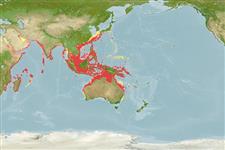Common names from other countries
>
Eupercaria/misc (Various families in series Eupercaria) >
Lutjanidae (Snappers) > Lutjaninae
Etymology: Lutjanus: Malay, ikan lutjan, name of a fish.
More on author: Cuvier.
Environment: milieu / climate zone / depth range / distribution range
Ecología
marino; salobre asociado a arrecife; rango de profundidad 5 - 180 m (Ref. 6390). Tropical; 34°N - 35°S, 30°E - 171°E (Ref. 55)
Indo-West Pacific: southern Red Sea and East Africa to New Caledonia, north to southern Japan, south to Australia.
Length at first maturity / Tamaño / Peso / Age
Maturity: Lm 54.2, range 49 - ? cm
Max length : 116 cm FL macho / no sexado; (Ref. 5738); common length : 60.0 cm TL macho / no sexado; (Ref. 55); peso máximo publicado: 32.7 kg (Ref. 5738); edad máxima reportada: 40 años (Ref. 96972)
Espinas dorsales (total) : 11; Radios blandos dorsales (total) : 15 - 16; Espinas anales: 3; Radios blandos anales: 10. Dorsal profile of head steeply sloped. Preorbital bone broad. Preopercular notch and knob moderately developed. Scale rows on back rising obliquely above lateral line. Generally red or pink, darker on the back; fins are red except the pectorals which is pink. Juveniles and small adults have a dark red band from first dorsal spine through eye to tip of snout; a 2nd band from mid-dorsal fin to pelvic fin; a 3rd from base of last dorsal spine to caudal peduncle. Large adults become uniformly red (Ref. 9710). Note: (TL, cm) = 1.00 + 1.24 (SL, cm); n = 828 (Ref. 1450). Body depth 2.6-3.0 in SL (Ref. 90102).
Adults occur in the vicinity of coral or rocky reefs (Ref. 5484), often over adjacent sand flats and gravel patches (Ref. 55). Also trawled in deeper water on relatively flat bottoms. Juveniles are frequently commensal with sea urchins (Ref. 55). Juveniles less than 20 cm long are common in near shore, turbid waters (Ref. 27260), in mangrove areas (Ref. 55), or among both coastal and deeper water offshore reefs (Ref. 27260). Juveniles can also be found swimming amongst the spines of urchins in shallow coastal bays (Ref. 48635). They move to deeper waters as they grow larger (Ref. 27264), with large fish often moving into shallower water during the winter months (Ref. 27260, 27264). They form schools of similar-sized individuals or are solitary (Ref. 6390). Feed on fishes, crabs, stomatopods, other benthic crustaceans and cephalopods. Marketed fresh, dried-salted and frozen (Ref. 9987). Commercially important but in certain regions of the Indian Ocean, large individuals are known to cause ciguatera poisoning (Ref. 11888).
Emperor red snappers are broadcast spawners (Ref. 28009).
Allen, G.R., 1985. FAO Species Catalogue. Vol. 6. Snappers of the world. An annotated and illustrated catalogue of lutjanid species known to date. FAO Fish. Synop. 125(6):208 p. Rome: FAO. (Ref. 55)
IUCN Red List Status (Ref. 130435)
CITES (Ref. 128078)
Not Evaluated
Threat to humans
Reports of ciguatera poisoning (Ref. 11888)
Human uses
Pesquerías: comercial; Acuicultura: comercial; pesca deportiva: si; Acuario: Comercial
Herramientas
Special reports
Download XML
Fuentes de Internet
Estimates based on models
Preferred temperature (Ref.
115969): 22.9 - 28.5, mean 27.1 (based on 1153 cells).
Phylogenetic diversity index (Ref.
82804): PD
50 = 0.5000 [Uniqueness, from 0.5 = low to 2.0 = high].
Bayesian length-weight: a=0.01413 (0.01053 - 0.01895), b=3.03 (2.94 - 3.12), in cm Total Length, based on LWR estimates for this species (Ref.
93245).
Nivel trófico (Ref.
69278): 4.1 ±0.4 se; based on diet studies.
Resiliencia (Ref.
120179): Medio, población duplicada en un tiempo mínimo de 1.4-4.4 años (K=0.13-0.38; tmax=35; Fec=5 million).
Fishing Vulnerability (Ref.
59153): High vulnerability (59 of 100).
